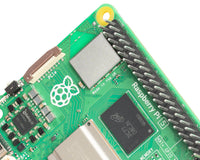
Raspberry Pi Roundup with a collect the dots game, new remote control software and a green-screen project
Collect the dots!

Albert Hickey is a big fan of using the SenseHAT on the Raspberry Pi and also of using Scratch, the visual programming language. So, he decided to use both with this simple game. You’re presented with a blue dot (which is you) and a red dot. By using either the SenseHAT joystick or the keyboard, you must ‘collect’ the red dot, at which point another red dot is spawned and on you go. The dots are shown on-screen as well as on the SenseHAT. The code is on GitHub or you can play it online without the SenseHAT by visiting Albert’s blog, where he’s written the project up. You can see the game in action in the video below:
Remote control

Andy Clark from RealVNC has just guest-blogged over at the Raspberry Pi website about the new version of VNC that is available now for the Raspberry Pi. And it’s available for free from the Raspbian repositories, meaning you can just type in the installation command and get it installed immediately. Called VNC Connect, it is a cloud-based service that allows your Pi to connect to it and then allow you to connect to your Pi, via the service website, from anywhere in the world. You can even play Minecraft Pi Edition remotely!
You can install it on your Pi by running the following commands
sudo apt-get update sudo apt-get install realvnc-vnc-server realvnc-vnc-viewer
Find out how to get set-up over on the RealVNC website and send then your feedback via Twitter or on the forums. You will need to register a new account on RealVNC to use the service.
Read more from Andy Clark here.
Green Screen

Another one from Albert Hickey who recently went to a Raspberry Jam and took along with him his latest project: a green-screen photo booth. The booth, which runs on a Raspberry Pi 3, uses Imagemagick to remove the colour green (provided by a green backdrop purchased from eBay) from an image taken using a camera module and then layering another image behind what’s left. The whole thing is carried out using a Python script. Albert got mixed results, due to shadows and lighting, but the overall effect is great. The code is available on GitHub and you can read about how to do it yourself over on Albert’s blog.





